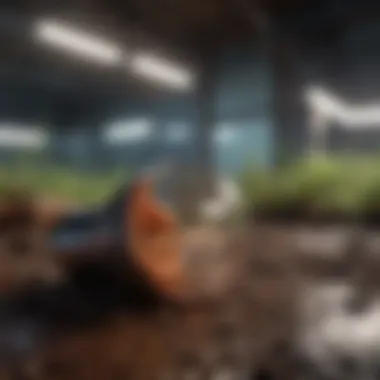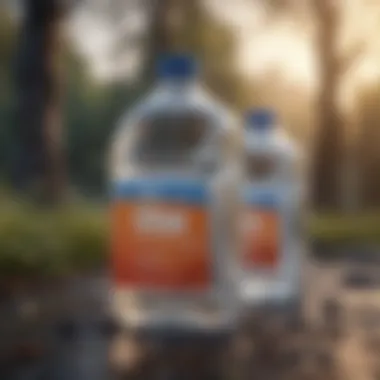Proper Disposal of Fluorescent Light Tubes: An In-Depth Guide for Environmental Responsibility


Overview of the Topic
Fluorescent light tubes pose a significant environmental challenge due to their mercury content and non-biodegradable nature. Understanding the importance of proper disposal is crucial to minimize harm to the environment and ensure public safety. By delving into safe disposal methods and responsible waste management practices, individuals can contribute to sustainable resource use.
Current Status and Challenges
The current state of fluorescent light tube disposal raises concerns about mercury contamination and inadequate recycling efforts. Improper disposal can lead to mercury leaching into soil and water sources, posing risks to ecosystems and human health. Challenges include limited awareness on safe disposal practices and insufficient recycling infrastructure to handle these hazardous materials effectively.
Sustainable Solutions
To address the challenges associated with fluorescent light tube disposal, sustainable solutions are essential. Encouraging proper disposal through awareness campaigns and implementing convenient recycling programs can improve recycling rates and reduce environmental impact. Successful case studies demonstrate the effectiveness of community-led initiatives and partnerships between industries and recycling facilities.
Impact and Importance
The impact of improper fluorescent light tube disposal extends to ecosystems, communities, and future generations. Mercury contamination can disrupt aquatic ecosystems, affecting biodiversity and food chains. Conserving resources and adopting sustainable waste management practices are crucial to mitigating these impacts and ensuring a healthier environment for all. The importance of conservation efforts and responsible waste disposal cannot be overstated, emphasizing the urgency for proactive measures in addressing this environmental challenge.
Introduction


In the realm of environmental consciousness, the proper disposal of fluorescent light tubes holds undeniable significance. These ubiquitous lighting fixtures, while beneficial to human activities, harbor environmental consequences if not handled correctly. As our society progresses towards sustainability, understanding the implications of fluorescent light tube disposal becomes imperative. By delving into the intricacies of this practice, individuals can contribute meaningfully to environmental preservation and safety standards within their communities.
Understanding the Environmental Impact
Amid the push for environmental stewardship, grasping the environmental impact of fluorescent light tube disposal is critical. These tubes contain mercury and other harmful substances, posing a threat to ecosystems and human health if not managed appropriately. Improper disposal can lead to soil and water contamination, affecting biodiversity and potentially endangering human populations. Therefore, comprehending the far-reaching implications of irresponsible disposal serves as a catalyst for embracing responsible waste management practices.
Importance of Proper Disposal
The importance of properly disposing of fluorescent light tubes cannot be overstated. Beyond the immediate benefits of avoiding fines for improper waste disposal, the essence of proper disposal lies in safeguarding our environment for future generations. By adhering to established disposal protocols, individuals demonstrate a commitment to mitigating pollution and reducing the carbon footprint associated with lighting solutions. Embracing proper disposal methods is not merely a regulatory requirement but a moral imperative in the pursuit of sustainability and environmental stewardship.
Disposal Methods
Proper disposal of fluorescent light tubes is crucial for environmental preservation and public safety. This section delves into various disposal methods, highlighting key strategies and considerations for effectively managing fluorescent light tube waste.
Local Recycling Centers
Local recycling centers play a pivotal role in sustainable waste management. These centers provide a convenient avenue for individuals to discard fluorescent light tubes responsibly. By utilizing local recycling facilities, individuals contribute to the reduction of landfill waste and promote the reuse of valuable resources. Moreover, recycling centers often implement specialized processes to handle fluorescent bulbs safely, minimizing the risk of environmental contamination. Ensuring that fluorescent light tubes are delivered to these designated facilities guarantees proper disposal and fosters a culture of eco-conscious waste management.
Retail Drop-Off Programs


Retail drop-off programs offer a hassle-free solution for disposing of fluorescent light tubes. Many retail establishments, such as hardware stores and home improvement centers, host drop-off points for used light bulbs. This initiative aims to simplify the disposal process for customers, encouraging them to recycle their fluorescent tubes correctly. By leveraging retail drop-off programs, individuals can conveniently drop off their old light tubes during shopping trips, promoting a sustainable approach to waste disposal. Embracing these programs instills a sense of environmental responsibility and encourages widespread participation in eco-friendly practices.
Mail-Back Programs
Mail-back programs present a convenient option for individuals seeking to dispose of fluorescent light tubes through mail services. These programs typically involve ordering a specialized container for light bulb transportation, followed by mailing the container to an appropriate waste management facility. By utilizing mail-back programs, individuals overcome logistical barriers associated with traditional disposal methods, ensuring that fluorescent tubes are recycled efficiently. This approach not only simplifies the disposal process but also facilitates the responsible management of hazardous waste, promoting a cleaner and safer environment.
Hazardous Waste Collection Events
Hazardous waste collection events serve as dedicated opportunities for the community to dispose of toxic materials, including fluorescent light tubes. These events are often organized by local authorities or environmental organizations to encourage safe disposal practices and prevent harmful substances from entering the environment. By participating in hazardous waste collection events, individuals can ensure that their fluorescent light tubes are handled and recycled in compliance with regulatory standards. This collaborative effort plays a vital role in safeguarding public health and ecosystems, underscoring the importance of responsible waste disposal within communities.
DIY Disposal Safety Measures
In this article about the proper disposal of fluorescent light tubes, an intricate aspect that requires meticulous attention is the DIY disposal safety measures. Understanding the ins and outs of handling and disposing of these tubes on your own is crucial for ensuring not only personal safety but also environmental protection. By delving into this topic, readers can grasp the significance of implementing proper safety protocols during the disposal process.
When it comes to DIY disposal safety measures, several key elements come into play. Firstly, one must comprehend the potential hazards associated with fluorescent light tubes, such as broken glass and toxic materials like mercury. By acknowledging these risks, individuals can take necessary precautions to minimize exposure and prevent accidents. Secondly, understanding the proper techniques for handling and transporting the tubes is essential. This includes wearing protective gear, such as gloves and safety glasses, to avoid direct contact with any harmful substances.
Moreover, DIY disposal safety measures offer various benefits beyond personal protection. By adhering to safety protocols, individuals contribute to the overall waste management scheme, reducing the likelihood of environmental contamination. Additionally, promoting awareness of safety practices fosters a culture of responsible waste disposal within communities, further resonating with the broader goal of sustainability.


When considering DIY disposal safety measures, it is essential to take certain considerations into account. Factors such as proper storage of used tubes, securing them to prevent breakage, and selecting appropriate transportation methods are critical aspects to ponder. By integrating these precautions into one's disposal routine, individuals can effectively mitigate risks and uphold safety standards.
Alternatives to Fluorescent Light Tubes
In the realm of sustainable lighting choices, exploring alternatives to fluorescent light tubes plays a pivotal role in environmental conservation and energy efficiency. By delving into alternatives that reduce harmful waste and energy consumption, individuals can make informed decisions that positively impact both the environment and their utility bills. Understanding the significance of transitioning to more eco-friendly lighting solutions sets the foundation for promoting a greener future.
LED Lighting Options
LED lighting stands out as a frontrunner among alternatives to fluorescent light tubes due to its energy-efficient nature and longevity. LEDs consume significantly less energy while offering greater durability, making them a cost-effective and eco-conscious choice for lighting needs. Additionally, the versatility of LED lights in terms of color temperature and designs makes them a versatile option for various settings, whether at home, in offices, or outdoor spaces. Incorporating LED lighting options not only reduces energy consumption but also minimizes carbon footprints, aligning with sustainability goals and conservation efforts.
Natural Lighting Solutions
Embracing natural lighting solutions presents another eco-friendly alternative to fluorescent light tubes. Harnessing natural light through strategically placed windows, skylights, or light tunnels not only reduces the reliance on artificial lighting sources but also enhances well-being by providing ample sunlight exposure. Natural lighting solutions promote energy efficiency by minimizing the need for electricity during daylight hours, contributing to reduced utility costs and environmental impact. Additionally, natural light plays a significant role in creating healthier indoor environments, fostering productivity, and enhancing mood and overall quality of life. By optimizing natural lighting solutions, individuals can cultivate sustainable practices that benefit both the planet and human well-being.
Conclusion
In this article, we have delved into the crucial topic of properly disposing of fluorescent light tubes. As our society progresses towards environmental consciousness, the significance of appropriately managing electronic waste like fluorescent tubes cannot be overstated. By comprehending the potential harm posed by improper disposal, individuals can play an active role in preserving our ecosystem. Additionally, adhering to correct disposal methods ensures not only environmental protection but also human health safeguarding. It is imperative to realize that every small act contributes to the larger scheme of sustainable living.
Summary of Best Practices
When considering the best practices for disposing of fluorescent light tubes, certain key factors emerge. Firstly, opting for local recycling centers or retail drop-off programs can streamline the disposal process while promoting resource reutilization. Secondly, individuals must prioritize safety precautions when handling and storing these tubes, as they contain hazardous materials. Minimizing exposure to harmful substances is vital for personal well-being and environmental conservation. Lastly, participating in hazardous waste collection events or mail-back programs showcases a commitment to responsible waste management practices.
Embracing Sustainable Lighting Choices
Embracing sustainable lighting choices goes beyond simply disposing of fluorescent light tubes. Considering alternatives like LED lighting options or natural lighting solutions showcases a proactive approach towards energy efficiency and reduced carbon footprint. LED lighting not only consumes less energy but also boasts a longer lifespan, translating to cost savings and environmental benefits. Natural lighting solutions, such as maximizing daylight usage, not only reduce reliance on artificial lighting but also enhance overall well-being. By embracing sustainable lighting choices, individuals align themselves with eco-friendly practices, contributing to a greener future for all.



